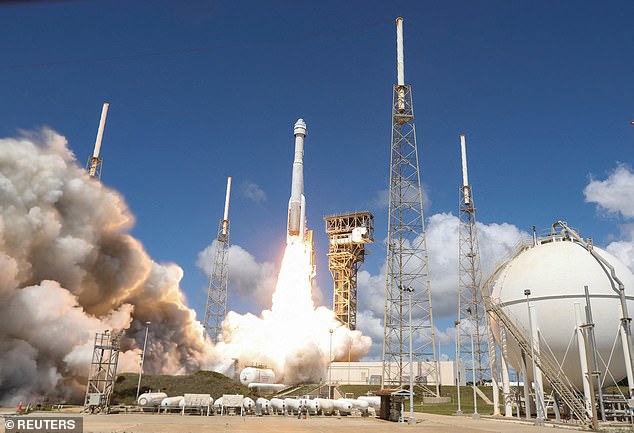Revealed: The shocking conditions endured by NASA astronauts stuck in space due to Boeing's faulty spaceship
Camping out in sleeping bags. Going days without washing. Facing life-altering health risks.
NASA's stranded astronauts Sunita Williams and Barry Wilmore are 'roughing it out' on the International Space Station as they remain stranded there with no official return date.
Boeing's faulty Starliner has extended what was supposed to be an eight day mission into a potential eight months of high stress and uncertainty.
Reports suggest the astronauts are living in less-than-ideal conditions, including a lack of proper sleeping arrangements, mounting psychological stress and increasing health risks.
But despite all of this, NASA officials boldly claimed the astronauts were loving it at a press briefing on Wednesday.

NASA officials insist that astronauts Barry Wilmore (left) and Sunita Williams (right) are 'doing fine' while stranded on the International Space Station, despite reports of rough conditions.
'I know if I was in their position I'd be really happy to be there,' Kenneth Bowersox, the associate administrator at NASA's Space Operations Mission Directorate, said.
'I'd be happy to have the extra time."
Each additional day they spend up there puts more strain on their bodies, as microgravity and space radiation deteriorate their health.
Williams and Wilmore were only supposed to be aboard the ISS for eight days when they launched on Boeing's Starliner in June, but an issue with the craft's thruster system means it's not safe to undock and bring them home.
NASA and Boeing have been working on a plan to return the astronauts safely to Earth, but won't have a decision until the end of the month, officials stated in the Wednesday briefing.
Officials are currently weighing the risks of sending Williams and Wilmore home on the faulty Starliner versus SpaceX's Crew Dragon spacecraft, which is scheduled to launch in September.
Going the SpaceX route would mean that the astronauts would remain on the ISS until February 2025, extending their mission to eight months.
An unexpectedly lengthy stay inside the cramped conditions of the ISS is bound to test the astronauts patience, especially when it comes to sleeping arrangements.

Boeing's faulty Starliner blasted off to the ISS carrying Williams and Wilmore in June. NASA and Boeing are still deciding whether the spacecraft is safe enough to bring them home.
The ISS is only equipped with six private sleep chambers, but there were already seven astronauts on board when Williams and Wilmore arrived, Time reported.
That means three of them are left without proper sleeping arrangements.
Williams and one of the astronauts who was already at the station are sleeping in less sophisticated sleep chambers called Crew Alternate Sleep Accommodations (CASA).
But Wilmore is forced to camp out in a sleeping bag inside Japanese Space Agency’s Kibo module.
'Butch is going to have to rough it a little bit,' Williams told Time editor Jeffrey Kluger, who spoke with the astronauts in May when they thought they would only endure these conditions for about a week.
Williams also expressed some discomfort due to lack of showers on the ISS during an interview with the Society of Women Engineers on August 8.
'Of course, we don’t have showers up here,' she said. 'Maybe I would’ve prepared a little bit better for that.'
She added that on the ISS, she can only wash her hair about twice a week.
Little annoyances like these can weigh on astronauts who spend long durations aboard the ISS, and can even give rise to psychological challenges.
In simulated space missions, some experience the 'third quarter phenomenon' - a dip in motivation occurs when astronauts realize the amount of time they have left in their situation is as much as they have already lived through.

Cramped conditions, lack of proper sleeping arrangements and psychological stress may be testing the stranded astronauts' patience.
This can leave them feeling irritable, tense and unmotivated.
Despite all these challenges, NASA officials say that Williams and Wilmore are having a grand time up there - for now.
They are enjoying the environment, "eating that great space food", and being able to look out the window, Bowersox said during the briefing.
'I know that they're making the best of this time, but I'm sure they're eager for a decision just like the rest of us,' he added.
But even if the astronauts are putting on a brave face, their bodies are suffering from the harsh conditions of spaceflight.
Many studies have found that long stints in space can cause bone density loss, muscle atrophy, intense radiation exposure, vision problems and other significant health issues.
Eight months wouldn't be the longest amount of time an astronaut has ever spent on the ISS.
But with each passing day, Williams and Wilmore are at greater risk of developing cancer, osteoporosis and diseases that may result from long-duration spaceflight.
At this time, NASA and Boeing are no closer to bringing the astronauts home, but are working to identify the safest return strategy.






















































































































































































































































